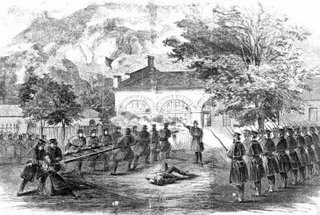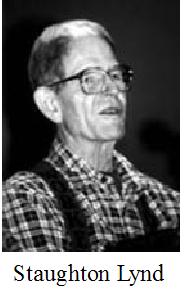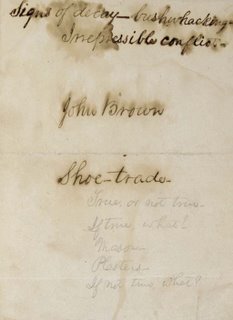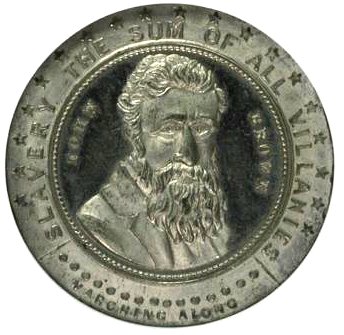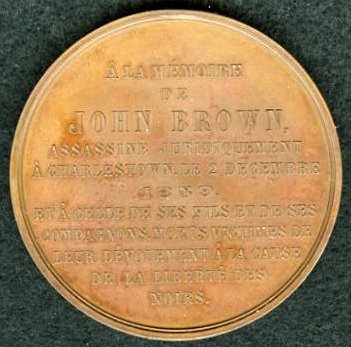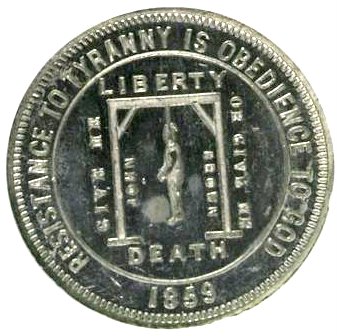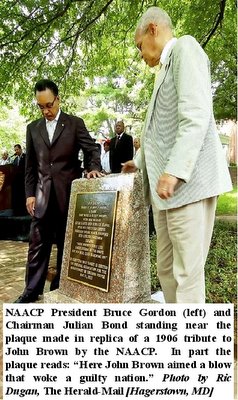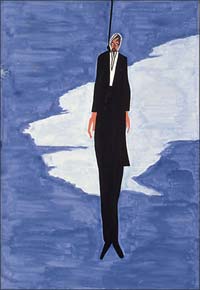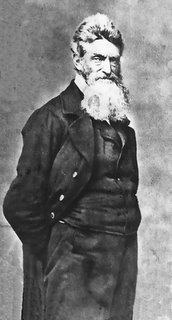 "Had I Interfered On Behalf of the Rich": John Brown's Final Speech--A Tribute and a Contemporary Application
"Had I Interfered On Behalf of the Rich": John Brown's Final Speech--A Tribute and a Contemporary ApplicationAfter speaking these words, Brown was sentenced to be hanged on December 2, 1859.I have, may it please the court, a few words to say. In the first place, I deny everything but what I have all along admitted -- the design on my part to free slaves. I intended certainly to have made a clean thing of that matter, as I did last winter when I went into Missouri and there took slaves without the snapping of a gun on either side, moving them through the country, and finally leaving them in Canada. I designed to have done the same thing again on a larger scale. That was all I intended to do. I never did intend murder or treason, or the destruction of property, or to excite or incite the slaves to rebellion, or to make insurrection. I have another objection; and that is that it is unjust that I should suffer such a penalty. Had I interfered in the manner which I admit, and which I admit has been fairly proved--for I admire the truthfulness and candor of the greater portion of the witnesses who have testified in this case--had I so interfered in behalf of the rich, the powerful, the intelligent, the so-called great, or in behalf of any of their friends, either father, mother, brother, sister, wife, or children, or any of that class, and suffered and sacrificed what I have in this interference, it would have been all right; and every man in this court would have deemed it an act worthy of reward rather than punishment. This court acknowledges, as I suppose, the validity of the law of God. I see a book kissed here which I suppose to be the Bible, or at least the New Testament, which teaches me that all things whatsoever I would that men should do to me, I should do even so to them. It teaches me, further, to "remember them that are in bonds, as bound with them." I endeavored to act up to that instruction. I say I am yet too young to understand that God is any respecter of persons. I believe that to have interfered as I have done, as I have always freely admitted I have done in behalf of His despised poor, is not wrong, but right. Now, if it is deemed necessary that I should forfeit my life for the furtherance of the ends of justice, and mingle my blood further with the blood of my children and with the blood of millions in this slave country whose rights are disregarded by wicked, cruel, and unjust enactments, I say let it be done. Let me say one word further. I feel entirely satisfied with the treatment I have received on my trial. Considering all the circumstances, it has been more generous than I expected. But I feel no consciousness of guilt. I have stated that from the first what was my intention and what was not. I never had any design against the liberty of any person, nor any disposition to commit treason, or excite slaves to rebel, or make any general insurrection. I never encouraged any man to do so, but always discouraged any idea of that kind. Let me say also in regard to the statements made by some of those connected who were connected with me, I fear it has been stated by some of them that I have induced them to join me, but the contrary is true. I do not say this to injure them, but as regretting their weakness. Not one but joined me of his own accord, and the greater part at their own expense. A number of them I never saw, and never had a word of conversation with till the day they came to me, and that was for the purpose I have stated. Now I am done.1
---------
1Transcript of Brown's speech taken from The Life, Trial and Execution of Captain John Brown (New York: Robert M. DeWitt Publishers, 1859), 94-95. This anonymously published collection of materials has been attributed to James Redpath, an associate and biographer of Brown.
---------
John Brown made a keen observation about the nature of "justice" in U.S. society, namely that the poor and oppressed constantly face a double standard. The rich and powerful see "law and order" as positive words, as the protection of their interests and the guarantee that the courts and constabularies will always protect their agendas and even provide escape for them from prosecution when they break the law. In contrast, people of color know that "law and order" means that they are forever at the disadvantage--especially at the hands of police and in the courts. Just recently we have seen yet another outrageous shooting of three unarmed black men in Queens, New York, one of whom perished in a hail of fifty bullets.
So despite the abolition of slavery, the guiding interests of wealth and race continue to drive this nation and while it is unpopular to say, the spirit of John Brown still broods over this nation, along with the souls of the oppressed, who watch this pretend democracy march onward into the 21st century without yet repenting of its guilt--which is in part why men like Brown will never be widely accepted or memorialized in this United States. "I say I am yet too young to understand that God is any respecter of persons," Brown told the court in 1859. In 2006, at the age of 206, his living soul is yet too young to grasp the ancient inequities that rule this nation. Justice-loving people like Brown could live 1000 years and never understand or live peacefully with the injustice that too many other Americans are content to live with from generation to generation.
In keeping with Brown's living legacy, then, I am pleased to present the insightful thoughts of Ezra Aharone, who would also speak to the issue of the great American plutocracy. His words speak to the present, not the past, and although the following essay is not directly related to John Brown, it is entirely consistent with the spirit of the man who was hanged on December 2, 1859 for laying his ax into the roots of a corrupt and unjust nation. --LD
 Voting for White Multimillionaires
Voting for White Multimillionaires
by Ezrah Aharone
To rousing applause, Bill Clinton remarked at Ossie Davis’ funeral that Davis: “Would have been a very good President of the United States.” Although he “would have,” the question is “could he have” been president? Despite this worthy praise of Davis, the record shows Black men are routinely shutout from winning high-elected offices of governors and senators – So forget about “president.” Just ask Jesse Jackson or Kweisi Mfume or Al Sharpton or Lynn Swann or Michael Steele to name a few. If 50 of the most prominent Black people were glued together, they wouldn’t comprise a candidate worthy enough for Euro-Americans to elect to the White House.
On Chris Matthews’ Decision 2006: Battleground America, an all-White panel discussed what they defined as “A hidden vote against African Americans.” Translation: “Whites who rah-rah-rah in popular public support for Black candidates, like Harold Ford Jr., but secretly vote for White candidates instead.” They represent a very real, but largely unacknowledged segment of Whites, who are psychologically incapable of voting Black people (regardless of qualifications) into high-elected offices. Nevertheless, Black America is not in short supply of intelligent and fully capable men and women who should be, and probably would be, elected to such offices – If they were the right color and class.
Former Governor of New Jersey, Richard Codey, called the U.S. Senate a “Club of multimillionaires.” More specifically however, it is a “Euro-American club of multimillionaires.” Those who are not, certainly have future options to rake-in multimillions. While in office they sit on key committees and enact favorable legislation for corporate interests, which ultimately lead to cushy jobs and corporate board appointments that guarantee them multimillions when they leave.
A thriving “Plutocratic Culture” exists between Blue-chip corporations and Blue-blooded Euro-Americans, where hundreds of millions of dollars change hands annually that impact campaigns, candidates, and election outcomes. America is a “Pay-to-Play Democracy” where members of this culture commonly hedge their odds by making hefty donations to both parties and both candidates in elections.
Plutocrats do not make generous contributions because of patriotism or kind-heartedness. They do so in exchange for political favoritism and privileges, and to influence policies that safeguard and advance their interests. When they sip champagne and eat caviar while attending black-tie fundraisers for $10,000 a plate, they do not discuss solutions to the proliferation of handguns and homicides in Black communities. They discuss issues that fatten their corporate coffers, like oil and natural gas reserves; the FED and interest rates; FDA approval of new drugs; genetically modified agriculture; and defense contracts.
Long before you supposedly “make your voice heard” on Election Tuesdays, a more authoritative voice has already spoken. … The dollars and support from this culture pre-select and pre-determine who is, and who isn’t, a viable candidate. Once you trace the major funding sources of a viable presidential, gubernatorial, or senatorial candidate, you can then largely pinpoint the issues/causes they’ll be pre-obligated to support while in office – Yet, voting is hyped and hailed as an instrument that makes American democracy so pristine and honorable.
Because of Black America’s long history of being forcibly denied the right to vote, we understandably attach great value and have deep reverence for the people and events that made voting possible. Even though we possess the right to vote and the right to run for offices, the contrived political engineering to fund and support select Euro-Americans, works like a well-oiled machine to systematically eliminate otherwise qualified Black candidates.
This does not however deter certain Black people from loading their pockets with “payoff” money from the very same political and corporate coffers that knowingly thwart their political rise. Realizing fully-well that they can never become a senator or governor, they cash-in as “party consultants” whose job is to endorse and campaign for White multimillionaires to increase Black voter turnout. This adds expanded dimensions to the act of “Pawned Sovereignty.” If there was such a crime as “political prostitution” some Blacks would be doing “life without parole.”
The new “political fad” nowadays is for Black people to be seen on television “grinning” at press conferences, while standing behind White multimillionaires who win elections. Since Black people in recent times couldn’t even enter the building where such press events were held, their presence presumably coveys a public showing of equality and inclusion, when in fact, there’s only been just 2 Black governors in all of history (Duval Patrick included); just 3 Black senators since reconstruction; and never more than 10 percent of Blacks in the House.
This constitutes a sophisticated modern-day form of repression, disguised in the notion that voting (for pre-selected White multimillionaires) somehow symbolizes freedom and equality. If the disproportionate numbers above exemplify political equality – What numbers would exemplify a case of inequality?
Two similarities in U.S. history standout. When Euro-Americans faced “Taxation without Representation,” they deemed it insufferable and eventually declared war against their British blood-relatives. When slaveholders lacked political representation, the infamous Three-Fifth Clause was enacted to count every 5 slaves in the census as 3 free people, thereby padding the population to increase the number of Congressmen in the South. Both objectives, by the way, were achieved at the expense and inhumanity of Black lives.
Some might contend that “we are all Americans,” and therefore, the color and multimillionaire status of candidates “do not matter.” But in any case, Black America is still underrepresented in high-elected offices when in reality we should rightfully have our own government and make sovereign decisions for ourselves. Therefore, to some of us “it does matter.” Especially during these chaotic political times, as the U.S. government’s protracted legacy of decimating people and cultures now extends into Iraq. So the next time you’re waiting in line to vote the next White multimillionaire into office, make sure you ask yourself – Does it matter?
~~~~~~~~~~
Copyright © 2006 Ezrah Aharone
Ezrah Aharone is a Scholar of Sovereign Studies and the author of Pawned Sovereignty: Sharpened Black Perspectives on Americanization, Africa, War and Reparations, http://www.1stbooks.com/bookview/18126. He can be reached at EzrahAharone@juno.com.
